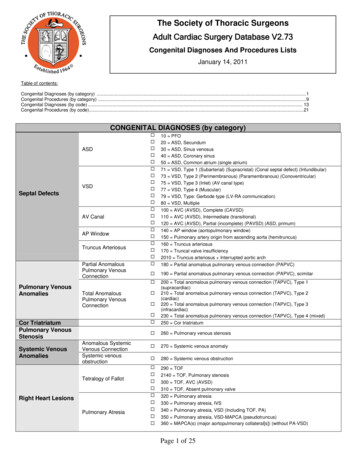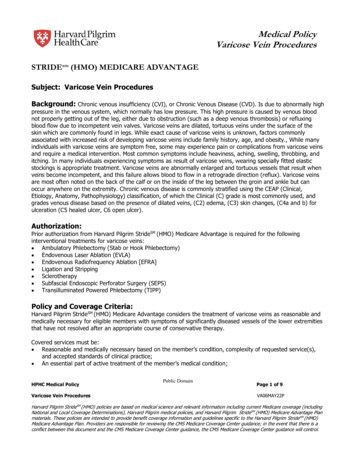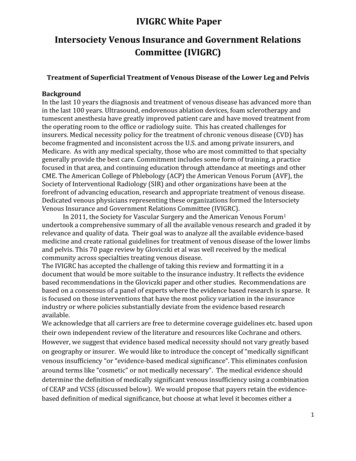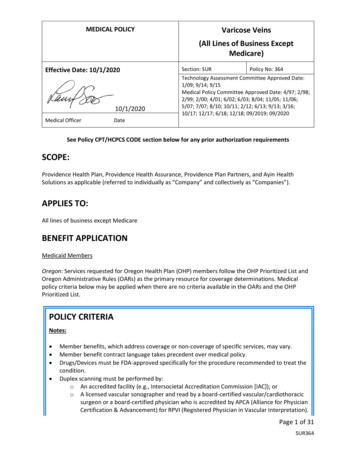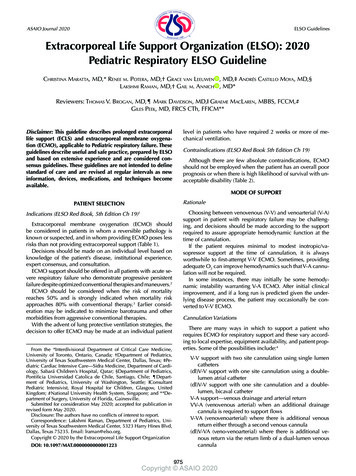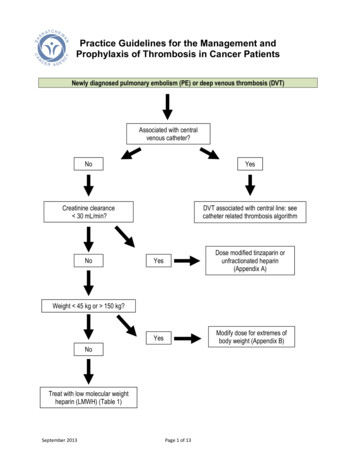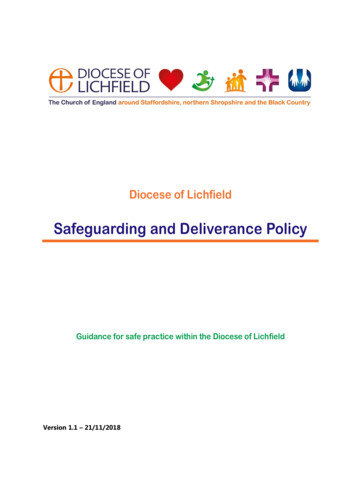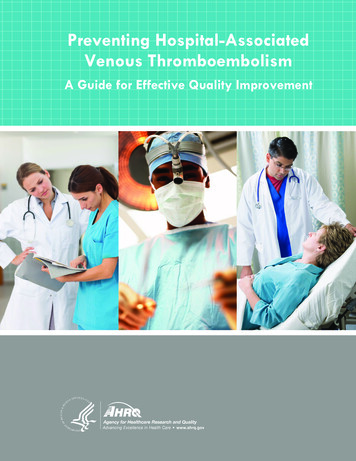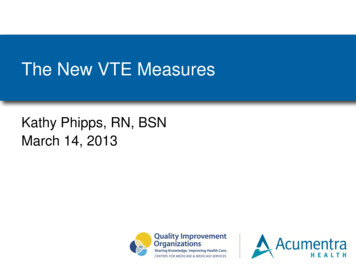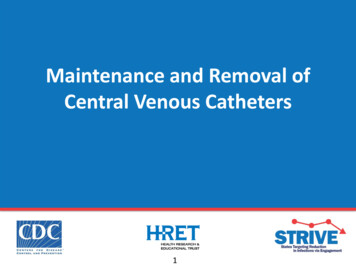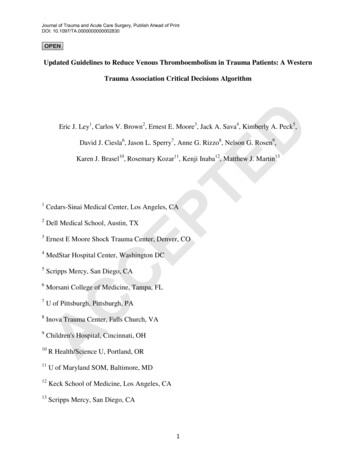
Transcription
Journal of Trauma and Acute Care Surgery, Publish Ahead of PrintDOI: 10.1097/TA.0000000000002830Updated Guidelines to Reduce Venous Thromboembolism in Trauma Patients: A WesternTrauma Association Critical Decisions AlgorithmDEric J. Ley1, Carlos V. Brown2, Ernest E. Moore3, Jack A. Sava4, Kimberly A. Peck5,David J. Ciesla6, Jason L. Sperry7, Anne G. Rizzo8, Nelson G. Rosen9,TEKaren J. Brasel10, Rosemary Kozar11, Kenji Inaba12, Matthew J. Martin13Cedars-Sinai Medical Center, Los Angeles, CA2Dell Medical School, Austin, TX3Ernest E Moore Shock Trauma Center, Denver, CO4MedStar Hospital Center, Washington DC5Scripps Mercy, San Diego, CA6Morsani College of Medicine, Tampa, FL7U of Pittsburgh, Pittsburgh, PA8Inova Trauma Center, Falls Church, VA9Children's Hospital, Cincinnati, OHACCEP110R Health/Science U, Portland, OR11U of Maryland SOM, Baltimore, MD12Keck School of Medicine, Los Angeles, CA13Scripps Mercy, San Diego, CA1
Presented at the 50th Annual Western Trauma Association Meeting, February 26, 2020 in SunValley, IdahoConflicts of Interest: The authors have no conflicts of interest to declare and have received noDfinancial or material support related to this manuscriptDisclaimer: The results and opinions expressed in this article are those of the authors, and do notTEreflect the opinions or official policy of any of the listed affiliated institutions, the United StatesArmy, or the Department of Defense (if military co-authors).Eric J. Ley, MD, FACSEPCorresponding Author:Cedars-Sinai Medical Center8635 W. 3rd Street, Suite 650WCLos Angeles, CA 90048AC818-203-1700This is an open-access article distributed under the terms of the Creative Commons AttributionNon Commercial-No Derivatives License 4.0 (CCBY-NC-ND), where it is permissible todownload and share the work provided it is properly cited. The work cannot be changed in anyway or used commercially without permission from the journal.Keywords: VTE; DVT; PE; prophylaxis, trauma, TBI, clot, thrombus2
INTRODUCTIONThis is a recommended evaluation and management algorithm from the Western TraumaAssociation (WTA) Algorithms Committee focused on the management of pharmacologicprophylaxis for venous thromboembolism (VTE) prevention in trauma patients. Because thereare few related published prospective, randomized clinical trials that have generated class I dataDon this topic in the trauma population, these recommendations are based primarily on publishedprospective and retrospective cohort studies, and expert opinion of the WTA members. The finalTEalgorithm is the result of an iterative process including an initial internal review and revision bythe WTA Algorithm Committee members, and then final revisions based on input during andEPafter presentation of the algorithm to the full WTA membership.GoalsThe algorithm (Figure 1) and accompanying comments represent a safe and sensibleapproach to reducing VTE in trauma patients. The aim for this approach is to provide updatedCguidelines which apply to most patients, most of the time. We recognize that there will beACmultiple factors that may warrant or require deviation from any single recommended algorithmand that no algorithm can completely replace expert bedside clinical judgment. We encourageinstitutions and clinicians to use this algorithm as a general framework in the approach to traumapatients and to customize and adapt it to better suit the specifics of that program or location.Burden of DiseaseVTE, including deep vein thrombosis (DVT) and pulmonary embolism (PE), is apotentially preventable complication after trauma. The focus of this algorithm is on optimizing3
the delivery of pharmacologic prophylaxis to prevent VTE and minimize any associatedcomplications. For those trauma patients diagnosed with a DVT or PE, including distal upperextremity or calf thrombosis, specific treatments are addressed in other guidelines and will not becovered in this algorithm.1, 2DWithout pharmacologic prophylaxis, a 1994 study determined the DVT rate was 58% inseverely injured trauma patients who undergo serial impedance plethysmography with lowerTEextremity contrast venography.3 In a landmark 1996 New England Journal of Medicinepublication subcutaneous enoxaparin 30mg twice daily performed better than subcutaneousheparin 5000u twice daily at reducing DVT in moderate to severely injured trauma patients (31%EPv. 44%, p 0.04).4 The risk of major bleeding was low regardless of therapy and, importantly, thefirst dose of pharmacologic prophylaxis was initiated within 36 hours of the injury and continuedthrough all surgical procedures except spinal fixation when a single preoperative dose was held. 4This study established that early, uninterrupted enoxaparin was superior to heparin at reducingCVTE after trauma. In the last decade a number of reviews and societal recommendations focusedon improving the guidelines to reduce the rate of VTE, and related complications, after trauma.1,AC2, 5-11Despite this progress, debate persists regarding optimal dosing and timing of enoxaparin,including when to initiate, hold, and resume it before and after surgery or epidural placement.Trauma patients frequently receive a delayed, suboptimal dose of enoxaparin which is then heldfor any potential surgical procedure despite substantial evidence that encourages early,4
uninterrupted pharmacologic prophylaxis. An updated algorithm on the appropriate managementof VTE prophylaxis is therefore indicated.ALGORITHMThe following lettered sections correspond to the letters identifying specific sections ofDthe algorithm shown in Figure 1. In each section we provide a brief summary of the importantaspects and options that should be considered at that point in the evaluation and managementTEprocess.A. This algorithm is designed for adult trauma patients 18 years and older. Importantly,EPalthough younger children have a significantly lower VTE risk, older children and adolescentshave a VTE risk that approaches their adult counterparts.12 Guidance for VTE prophylaxis inchildren can be found in the joint practice management guideline from the Pediatric TraumaSociety and the Eastern Association for the Surgery of Trauma, which recommends,C“pharmacologic prophylaxis be considered for children older than 15 years old and in youngerACpostpubertal children with Injury Severity Score (ISS) greater than 25.” 11B. Assessment of VTE risk will assist in determining which patients require pharmacologicprophylaxis. In general, an ISS of 10 or more suggests that pharmacologic prophylaxis shouldbe initiated as soon as possible, whereas patients with an ISS less than 10 are at lower VTE riskand may not require pharmacologic prophylaxis.13-15 As ISS is not calculated in real time, theGreenfield Risk Assessment Profile or the Trauma Embolic Scoring System can assist withcalculating VTE risk.13-15 Patients with spine or pelvic fractures, repair of venous injury, a5
history of VTE, or inherited clotting disorders have increased VTE risk and should be consideredfor pharmacologic prophylaxis.2, 13, 14 Among trauma patients with minor injuries, independentpredictors of increased VTE risk are increased age, obesity, and lower extremity fractures; anycombination of these three characteristics should encourage initiation of pharmacologicDprophylaxis.13C. Patients with minor trauma may not require pharmacologic prophylaxis. Given the relatedTEpain with injection, potential for hematoma at the injection site, cost for the medication, andnursing costs for administration, avoiding pharmacologic prophylaxis may be indicated for selectlow risk patients after minor trauma. The Trauma Embolic Scoring System can be used to assessEPVTE risk as patients with a low score require no pharmacologic prophylaxis due to their lowVTE rate.13 Ambulatory patients with minor injuries and short hospital stays may not requirepharmacologic prophylaxis. Trauma patients capable of ambulation but confined to bed due tointoxication, restraints, or other reasons should receive pharmacologic prophylaxis. In general,Ctrauma patients who require hospital admission for more than 24 hours require pharmacologicACprophylaxis whereas those hospitalized for less than 24 hours do not. For the patients who do notreceive pharmacologic prophylaxis, mechanical prophylaxis and/or aspirin are low cost and lowmorbidity options, although their benefit is uncertain given the low VTE rate.13-16D. Appropriate delays in pharmacologic prophylaxis may occur for those patients with anactive bleed, coagulopathy, hemodynamic instability, solid organ injury, traumatic braininjury (TBI), or spinal trauma. Quantifying the risk and benefits of initiating pharmacologicprophylaxis for each patient is a challenge that is best determined by the trauma team at bedside.6
Detailing every indication where a delay may be indicated is outside the scope of theseguidelines; several are described below. However, it is important to note that the guidance inboth the literature and clinical practice supports very short delays to the initiation ofActive bleeding, coagulopathy, or hemodynamic instabilityDpharmacologic prophylaxis, even among these cohorts.Control of active bleeding is necessary before starting pharmacologic prophylaxis. In theTEpresence of hemodynamic instability, a hemoglobin drop of greater than two g/dl in under 12hours or ongoing blood transfusion is an appropriate indication to delay the initiation ofpharmacologic prophylaxis.2, 4 Systemic coagulopathy was previously proposed as a reason toEPdelay pharmacologic prophylaxis with one study holding pharmacologic prophylaxis for anelevated prothrombin time (PT) more than 3 seconds above control or a platelet count of lessthan 50,000 per cubic millimeter. 4 More recent studies indicate that PT and platelet count are notas reliable at predicting systemic coagulopathy as viscoelastic hemostatic assays, which mayCdemonstrate hypocoagulability and hypercoagulability after trauma.2, 17-19 The hypocoagulabilityACdue to trauma largely resolves within 24 hours, after which hypercoagulability becomesprevalent. In this setting pharmacologic prophylaxis may be considered after the initialresuscitation is complete.17,20Deferring the initiation of pharmacologic prophylaxis duringtrauma induced coagulopathy (TIC) is associated with an increased VTE rate such that theinitiation of pharmacologic prophylaxis is encouraged if the hypocoagulable state is expected toresolve and there are no signs of ongoing bleeding.177
Solid organ injuryDelays occur in the initiation of pharmacologic prophylaxis for patients with solid organ injury.Several studies indicate that patients with solid organ injury who received early pharmacologicprophylaxis had lower DVT and PE rates without increased risk of failure of nonoperativemanagement, bleeding complications, or mortality; these risks did not increase whenDpharmacologic prophylaxis was started within 24 hours compared to within 48 hours.20-23 Earlypharmacologic prophylaxis within 12 to 24 hours appeared to be safe across moderate AmericanTEAssociation for the Surgery of Trauma injury grade and type of solid organ injury (liver, spleen,and/or kidney), without an increased risk of bleeding that necessitated intervention or bloodtransfusion.21 Although those with grade IV and V injuries should be approached with caution,injury.21-23Traumatic brain injuryEPpharmacologic prophylaxis may be initiated within 24 hours for most patients with solid organCConcern for progression of TBI is a common reason for the delay in initiation of pharmacologicprophylaxis. This delay is dependent on the type of TBI, those with “cerebral contusion,AClocalized petechial hemorrhages, or diffuse axonal damage” may safely receive pharmacologicprophylaxis without delay.4 When pharmacologic prophylaxis is appropriately delayed, thefollow up CT after TBI diagnosis is an important indicator for when to initiate pharmacologicprophylaxis.24 For patients with TBI progression on the follow up CT, exposure topharmacologic prophylaxis is a predictor for further progression and it should be held until afollow up CT demonstrates no progression.24 In contrast, if the follow up CT demonstrates noTBI progression then pharmacologic prophylaxis should be initiated.824Importantly, progression
of TBI occurs in about 10% of patients with a stable follow up CT, regardless of whetherpharmacologic prophylaxis is provided or not.24 Those trauma centers which providepharmacologic prophylaxis within 24 hours after TBI have significantly lower rates of VTE withno difference in rates of late neurosurgical intervention.23,25-30Even in the setting of combatrelated penetrating TBI, initiating pharmacologic prophylaxis 24 hours after injury for thoseDpatients with a stable CT was safe, with similar progression rates regardless of pharmacologicprophylaxis.29 The majority of TBI patients with a stable CT may be initiated on enoxaparinTEwithin 24 hours and nearly all TBI patients should receive pharmacologic prophylaxis within 72hours of the time of injury.23, 28, 31EPSpinal traumaIn the absence of pharmacologic prophylaxis, patients who undergo spine surgery or those withspine trauma, fracture, or cord injury have a high incidence of VTE2, and delays longer than72 hours lead to a substantial increase in the VTE rate.32 Pharmacologic prophylaxis must beCinitiated as soon as possible after spine surgery or any spine injury.32, 33Regimens that providepharmacologic prophylaxis preoperatively34 or immediately after operative fixation areACconsidered safe.4, 34 When a departmental protocol was implemented that required pharmacologicprophylaxis preoperatively or the same day of spine surgery, the VTE rate decreased and the rateof spinal hematoma was unchanged.34Similarly, pharmacologic prophylaxis initiated within 48hours of operative fixation of traumatic spine fractures did not increase the risk of bleeding,progression of neurological injury, or postoperative complications including spinal hematoma.23,339
EMechanical prophylaxis for moderate to high VTE risk patients is encouragedregardless of concurrent pharmacologic prophylaxis. For patients who are not startedimmediately on pharmacologic prophylaxis, mechanical prophylaxis with intermittent pneumaticcompression and mobilization, when possible, should be encouraged. Intermittent pneumaticcompression lowers the DVT incidence if no pharmacologic prophylaxis is initiated and36Dtherefore is recommended for patients with a contraindication to pharmacologic prophylaxis.2, 35,In contrast, the addition of intermittent pneumatic compression in critically ill patients whoTEreceived pharmacologic prophylaxis did not lead to a reduction in the DVT rate, although thestudy had a low DVT rate and only 8% of the population were trauma patients.16 Combiningmechanical prophylaxis with pharmacologic prophylaxis is therefore encouraged for moderate toEPhigh VTE risk patients in part because those who received the combination had a lowerincidence of symptomatic PE.35 Compression stockings do not appear to reduce the VTE rate inthe presence of pharmacologic prophylaxis16, but thigh high compression stockings may provideCa benefit to those trauma patients who cannot be started on pharmacologic prophylaxis.2Mobility is also an important component for VTE prevention as early mobility leads to aACreduction in VTE.37 A mobility protocol is safe in trauma patients and may reduce patientdeconditioning besides decreasing the rate of VTE.37 Prolonged maintenance of spinalprecautions is associated with an increased DVT rate and should be avoided to allow earlymobility.38FWeekly venous compression duplex should be considered in patients at high VTErisk who cannot be started or maintained on pharmacologic prophylaxis. Although debate10
persists, routine surveillance with venous compression duplex is not indicated or feasible for alltrauma patients. 2 Routine surveillance duplex after trauma does not decrease the risk of PE orfatal PE, and false positive results lead to unnecessary therapeutic anticoagulation. 2 In traumapatients at low VTE risk, the high cost and low yield of acute, clinically relevant findings suggestthe practice may be avoided. Some institutions advocate for routine surveillance in low riskDtrauma patients to identify both acute and preexisting DVT, which may help identify and treatthe related complications such as venous insufficiency, venous stasis ulcers, or pain with39For trauma patients at high VTE risk routine surveillance duplex is associatedTEambulation.with a reduced PE rate.39 The Greenfield Risk Assessment Profile can identify which traumapatients may benefit from routine surveillance.14, 39 Weekly duplex scanning may be particularlyEPbeneficial in high VTE risk patients who cannot be started or maintained on pharmacologicprophylaxis. Whatever the institutional guidelines, identification of DVT should not be a hospitalreported outcome. Institutions that routinely screen all trauma patients have higher rates of DVTand those centers with comprehensive quality improvement efforts that do not routinely screenACduplex.Cwill also have higher DVT rates due to a lower threshold for ordering a venous compressionGPharmacologic prophylaxis should be initiated as soon as possible and for mosttrauma patients may be initiated within 24 hours. When high VTE risk trauma patients whoreceive enoxaparin within 24 hours of admission are compared to those who receive onlymechanical prophylaxis, minor and major bleeding events do not differ.40 As detailed in sectionE, appropriate delays may occur in the initiation of pharmacologic prophylaxis due to activebleeding, coagulopathy, hemodynamic instability, solid organ injury, traumatic brain injury, or11
spinal trauma. In most cases pharmacologic prophylaxis may be started in under 24 hours and inalmost every case pharmacologic prophylaxis may be started in under 72 hours.Pharmacologic prophylaxis is often held due to pending surgery despite the evidence that it maybe initiated prior to most surgical procedures.4, 41-43 Trauma patients who require an operation areDunique in that their first operation may occur within minutes of arrival or days into thehospitalization. Increasingly, pharmacologic prophylaxis is delayed or skipped for pendingTEsurgery which leads to an increased VTE rate.40 Preoperative dosing of pharmacologicprophylaxis is not unique to trauma. In other patient populations at high risk for VTE, the use ofpreoperative pharmacologic prophylaxis decreased the DVT rate without increasing the42Guidelines for perioperative care in gynecologic/oncology recommend,EPcomplication rate.41,“Prophylaxis should be initiated pre-operatively and continued post-operatively.”44 Patients whounderwent elective hip surgery who received low molecular weight heparin approximately sixhours prior to surgery had a lower rate of proximal DVT without increasing major, minor, orCtrivial bleeding rates.43 This benefit was not observed when low molecular weight heparin wasACprovided 12 hours or more preoperatively.43 We believe that the common and somewhatreflexive process of withholding pharmacologic prophylaxis for 12 to 24 hours prior to plannedsurgical procedures is almost always unnecessary, and will result in an increased VTE riskwithout an accompanying decrease in the risk of bleeding events.HAfter deciding to start pharmacologic prophylaxis, the specific anticoagulant andinitial dose should be determined for each patient. Enoxaparin is the recommended choicefor most trauma patients with higher doses now considered the standard of care. The12
preferred agent for pharmacologic prophylaxis is the low molecular weight heparin enoxaparindue to its increased bioavailability, longer plasma-half life, and more predictablepharmacokinetics and pharmacodynamics compared to unfractionated heparin.4,45Enoxaparininteracts less with platelets which may reduce bleeding complications compared withunfractionated heparin, has a lower incidence of heparin induced thrombocytopenia, and does notDhave the associated osteoporosis observed with heparin treatment.46TEWhen choosing the initial dose, enoxaparin 40mg twice daily should be considered the standardfor most trauma patients as 30mg twice daily frequently results in inadequate pharmacologicprophylaxis.47-55 Therefore, patients 18 to 65 years with weight above 50kg, and a creatinineEPclearance above 60mg/dl should be started on enoxaparin 40mg twice daily as this dose is safeand reduces the VTE rate.47-55 Patients who are older than 65 years, weigh less than 50 kg, orwho have a creatinine clearance of 30-60mg/dl should continue to receive initial dosing atCenoxaparin 30mg twice daily.The initial enoxaparin dose for trauma patients with a normal creatine clearance may also beACbased on weight. Options include 0.5mg/kg twice daily51, 52 , 0.6mg/kg twice daily53, or 30mg for50-60kg patients, 40mg for 61-99kg patients, and 50mg for patients greater than 100kg.54Patients who are initiated on higher doses of enoxaparin based upon weight should be monitoredby anti Xa levels due to the fluctuations in creatinine clearance after trauma that might lead tochanges in the enoxaparin dose.5013
Although enoxaparin is preferable to heparin for pharmacologic prophylaxis, some institutionscontinue to dose unfractionated heparin at 5000u three times daily based in part on a randomizedtrial that suggested this regimen might be noninferior and cost effective compared to enoxaparin30mg twice daily.56 This practice should be reconsidered as the trial was underpowered due to anassumed DVT rate of 44% for unfractionated heparin versus 31% for enoxaparin, and a 10%Dnoninferiority margin for the power calculation. The actual difference in the VTE rate was 3.1%which favored enoxaparin without reaching significance (Unfractionated heparin 8.2% v.TEenoxaparin 5.1%, p 0.2).45, 56 In addition, the study was not powered to detect a difference in therate of pulmonary embolism or heparin induced thrombocytopenia, both of which impact thecomplication rate and health care costs.45, 57 More recently, enoxaparin 30mg twice daily wasVTE and PE.45EPestablished as superior to unfractionated heparin 5000u three times daily at the prevention ofUnfractionated heparin for renal failureCIn the presence of end stage renal disease or a creatinine clearance 30mg/dl, subcutaneousACunfractionated heparin at 5000u every eight hours may be initiated.2 As enoxaparin is excretedby the kidneys, its administration to patients with renal failure may lead to increased bleedingcomplications and should be avoided.2 Enoxaparin has not been FDA approved for use indialysis patients. Providing lower enoxaparin doses in the setting of a creatinine clearance 30mg/dl while closely monitoring anti Xa levels may be possible in the future, but additionalresearch is necessary before this recommendation can be made. In most other settings,enoxaparin is preferable to unfractionated heparin as enoxaparin leads to lower VTE rateswithout increased bleeding complications.4, 4514
Brain and spine traumaFor TBI patients, enoxaparin is associated with less VTE and higher survival than unfractionatedheparin with no difference in the progression of brain lesions, regardless if the dose wasdelivered in under 24 hours after admission, between 24 to 48 hours, or after 48 hours.2633DSimilarly, those patients with spine trauma should preferentially receive early enoxaparin. 32,Patients with brain and spine trauma should be initiated on enoxaparin 30 mg twice daily andTEconsidered for dose adjustment by anti Xa level.4, 47Pregnant patientsEPPregnant patients require specific dose recommendations for pharmacologic prophylaxis aftertrauma due to the progressive hypercoagulability,58 as well as the increase in renal clearance andweight changes that occur over the course of pregnancy.59 These variables generally requirehigher enoxaparin doses with more frequent dosing. Neither unfractionated heparin norCenoxaparin crosses the placenta, and both are considered safe to use in pregnancy.58-60 As such,ACduring an admission for trauma, pregnant patients should receive enoxaparin 30mg twice dailytitrated by anti Xa levels targeting a peak range of 0.2-0.4 IU/ml or a trough range of 0.1-0.2IU/ml. For pregnant patients who weigh more than 90kg initiating enoxaparin 40mg twice dailyis recommended with similar anti Xa level titration.58-60Isolated orthopedic injuries and direct oral anticoagulantsPharmacologic prophylaxis with direct oral anticoagulants (DOACs) or aspirin should not be aprimary choice for pharmacologic prophylaxis for most trauma patients due to the lack of related15
clinical trials. The use of DOACs or aspirin may be considered in the setting of isolatedorthopedic injuries, but only if the patient declines injection with enoxaparin or unfractionatedheparin.5,61-66Two DOACs are approved for pharmacologic prophylaxis after electiveorthopedic surgery, rivaroxaban 10mg once daily and apixaban 2.5 mg twice daily, both whichare direct oral factor Xa inhibitors. Most orthopedic trials that compare rivaroxaban or apixabanDto enoxaparin demonstrate DOACs have equal to better VTE rates with similar to higherbleeding rates.62-64, 66-68 In contrast, other analyses conclude that enoxaparin has a lower VTE69and a lower bleeding rate.70 As only retrospective analyses have examined the use ofTErateDOACs for pharmacologic prophylaxis after trauma, randomized controlled trials are necessaryprior to DOACs becoming a primary agent for trauma patients.66,71, 72The use of low doseEPaspirin may also be considered for pharmacologic prophylaxis in trauma patients with isolatedorthopedic injuries who decline injection.2, 5, 69, 73 For those trauma patients started on a DOACfor pharmacologic prophylaxis, aspirin may replace the DOAC after 5 days with similarMany trauma patients require dose adjustment after initiating enoxaparin. Due toACICprevention of VTE.74the variations in renal clearance, weight, bioavailability, and coagulation cascade, monitoringenoxaparin by anti Xa levels is necessary. In one series 84% of trauma patients required doses of40mg or more, and 18% required doses of 50mg or more.47 Adjusting enoxaparin by anti Xapeak or trough levels appears to lead to a lower VTE rate without increasing bleedingcomplications in moderate to severely injured patients, trauma patients who require ICUadmission, burn injuries, and surgical oncology patients.47-49, 75 Although some debate exists onthe appropriate target for anti Xa levels, consensus suggests targeting 0.2–0.4 IU/mL for peak16
levels or 0.1-0.2 IU/mL for trough levels.47-50,55, 75, 76Anti Xa monitoring should also beconsidered for those patients who receive weight-based enoxaparin.50, 53, 76Although thromboelastography (TEG) has not been validated for monitoring pharmacologicprophylaxis, TEG with platelet mapping may assist with monitoring platelet inhibition. ADrandomized trial which utilized TEG as an adjunct to identify inadequate enoxaparin doses didnot observe lower rates of VTE with the TEG guided enoxaparin dosing.77 In contrast, TEG withTEplatelet mapping may help determine if a hypercoagulability is due to platelet function whichencourages the addition of aspirin to the pharmacologic prophylaxis regimen.78 If aspirin isadded the initial recommended dose is 81mg daily with the possibility of increasing the dose toJEP325mg daily depending on subsequent TEG with platelet mapping results.18, 19The continuous, uninterrupted dosing of pharmacologic prophylaxis should be thestandard for most trauma patients throughout their hospital stay. Although the safety andCbenefit of uninterrupted pharmacologic prophylaxis was established decades ago, over half ofACtrauma patients encounter interruptions.79, 80 A direct correlation is observed between the numberof missed doses and DVT risk such that patients who miss two doses have 8.5 times higher DVTrisk compared to those with no missed doses.80 For TBI patients who are started onpharmacologic prophylaxis, interrupted dosing causes an approximately 600% increase in theVTE rate.81The following are common reasons for missed pharmacologic prophylaxis: pending invasiveprocedure (41.6%), none (27.1%), patient absent from the room (11.7%), concern for bleeding17
(12.1%), epidural catheter removal (5.9%), and physician/nursing error (1.6%).80 When holdingpharmacologic prophylaxis, the rate of bleeding with pharmacologic prophylaxis is no differentthan without it.40If nonfatal VTE events are compared to nonfatal bleeding complications, therisk/benefit ratio favors continuing pharmacologic prophylaxis.82 Every effort should focus oncontinuing pharmacologic prophylaxis without interruption. The appropriate indications forDholding or altering pharmacologic prophylaxis include acute thrombus, craniotomy, spinalsurgery, epidural placement, or heparin induced thrombocytopenia and these are expanded uponTEbelow.Acute thrombusEPAlthough routine VTE surveillance is not indicated for all trauma patients 2, weekly duplexscanning may be warranted in those at high VTE risk.39 Selective venous ultrasound should beperformed promptly for symptomatic evidence of DVT such as unexpected leg swelling or pain. 6For those trauma patients with significant injuries and gaps in pharmacologic prophylaxis,Cweekly ultrasound may be considered.39 If a DVT or PE is identified then therapeuticanticoagulation is necessary per current guidelines and if it is contraindicated then an IVC filterACshould be considered as detailed in section K.1Pending surgeryAs discussed in section G, routinely holding pharmacologic prophylaxis due to pending surgeryis only indicated, with few exceptions, for brain or spine surgery.4 Given the delays andcancellations of cases that may occur during trauma patient care, holding pharmacologicproph
Without pharmacologic prophylaxis, a 1994 study determined the DVT rate was 58% in severely injured trauma patients who undergo serial impedance plethysmography with lower extremity contrast venography.3 In a landmark 1996 New England Journal of Medicine publication subcutaneous enoxaparin 30mg twice daily performed better than subcutaneous .
